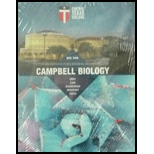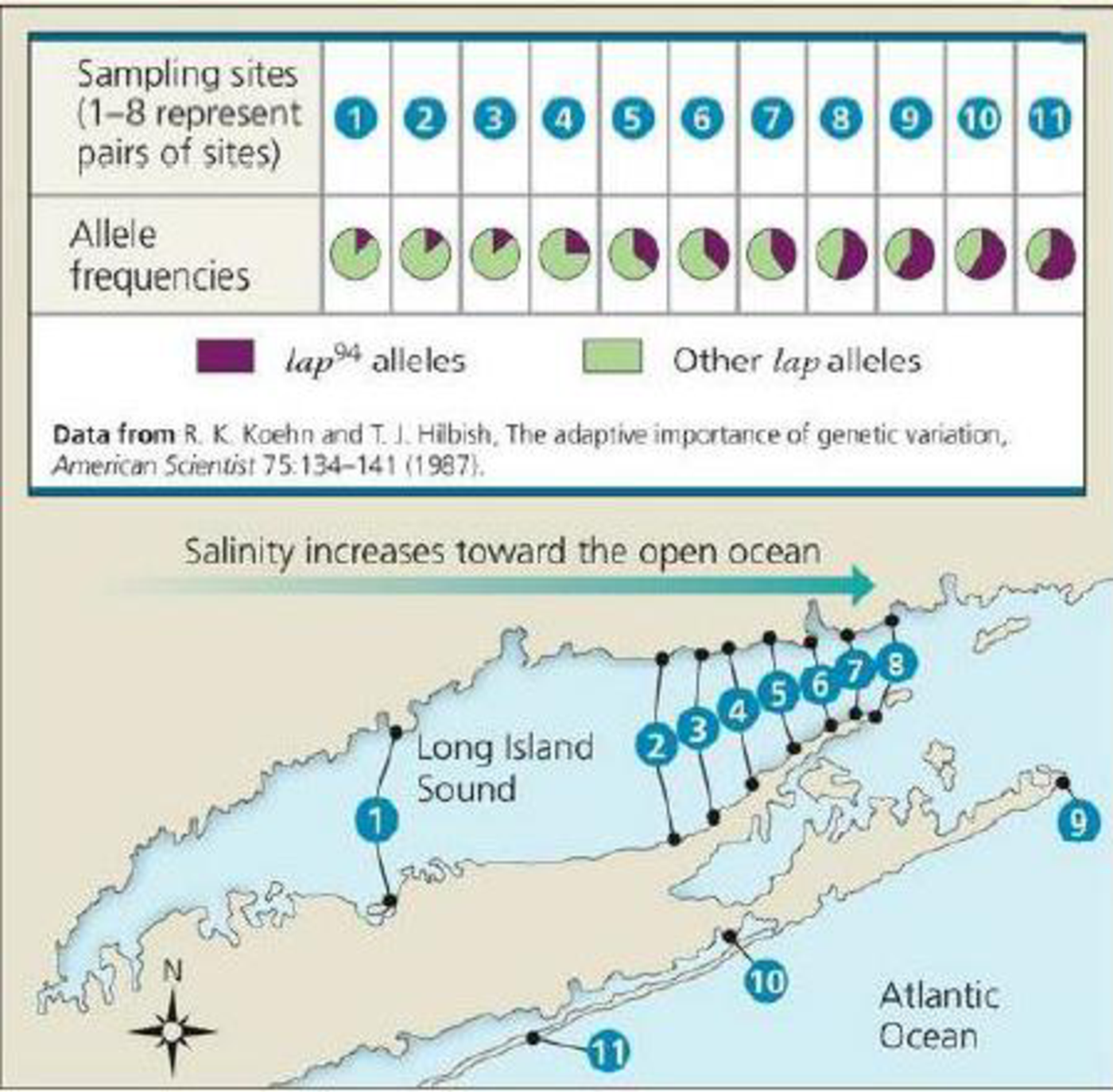
Concept explainers
SCIENTIFIC INQUIRY • INTERPRET THE DATA Researchers studied

mechanisms that can alter allele frequency, construct a hypothesis that explains the patterns you observe in the data and that accounts for the following observations: (1) The lap94 allele helps mussels maintain osmotic balance in water with a high salt concentration but is costly to use in less salty water;
and (2) mussels produce larvae that can disperse long distances before they settle on rocks and grow into adults.
Want to see the full answer?
Check out a sample textbook solution
Chapter 23 Solutions
CAMPBELL BIOLOGY (LL) >CUSTOM PKG.<
- Shrimp fishing off the coast of Georgia was closed in 2001, due to a drastic reduction in the shrimp population. Landings of blue crab plummeted in 2002 and 2003, as five years of drought and greatly reduced freshwater flow from underground aquifers led to increased salinity in coastal estuaries. These habitats between open ocean and fresh water are the “nurseries’ for many marine animals. Using information you learned in this lab, speculate about possible causes for the decline in shrimp and blue crab populations.arrow_forwardSCENARIO: Ecologists have recently made an observation regarding a species of nematode (round worm) commonly found in Australian soils with two distinct phenotypes appearing, the mutant form appears to have increased cuticle formation. This species is a crucial part of their ecosystem’s food web and is a predator of many soil microbes. The divergent phenotype appears to negatively affect its predatory behaviour, which could have disastrous flow on effects to the rest of the ecosystem. Preliminary studies also indicate this phenotype has a genetic basis, so is not caused by infection. You have been tasked with uncovering the genetic basis of this phenotype. Q1. Given the phenotype blister nematode leads to a negative impact on the nematode’s predatory behaviour, develop a hypothesis as to why this phenotype is increasing among the population (i.e. it is being positively selected for): Q2. Briefly describe an experiment you could use to test this hypothesis:arrow_forwardSCENARIO: Ecologists have recently made an observation regarding a species of nematode (round worm) commonly found in Australian soils with two distinct phenotypes appearing, the mutant form appears to have increased cuticle formation. This species is a crucial part of their ecosystem’s food web and is a predator of many soil microbes. The divergent phenotype appears to negatively affect its predatory behaviour, which could have disastrous flow on effects to the rest of the ecosystem. Preliminary studies also indicate this phenotype has a genetic basis, so is not caused by infection. You have been tasked with uncovering the genetic basis of this phenotype. Q6. Given the phenotype leads to a negative impact on the nematode’s predatory behaviour, develop a hypothesis as to why this phenotype is increasing among the population (i.e. it is being positively selected for): Q7. Briefly describe an experiment you could use to test this hypothesis:arrow_forward
- A research team conducted a project where they artificially increased the CO2 levels in tanks containing corals. They found an inverse relationship between reef building and atmospheric CO2. This experiment __________. Options: A. is not possible. Increased CO2 should not affect the reef, as it is a relatively inert gas. B. represents the situation in the pre-industrial age, with less reef-building occurring than now C. indicates that marine ecosystems are unlikely to be affected by rising CO2 levels D. indicates that available calcium carbonate levels will increase with increasing levels of CO2 E. indicates that even though the oceans may be good sinks for CO2, there will be negative impacts of increasing levels of atmospheric CO2 beyond the greenhouse effectarrow_forwardThe Lazy River Environmental Group is a group of fishermen and environmentalists that have worked to assess and clean up the pollution from an old factory on the Lazy River. One early study revealed that species on the river had absorbed pollutants from the water. Select the Pollutant Levels in Tissue, by Species dataset and follow the interactive to graph the data. Which statement(s) correctly describe the graph? (Check all that apply.) The two species with highest levels are both fish.The two species with highest levels are both fish. Turtles had a pollutant level about three times that of clams.Turtles had a pollutant level about three times that of clams. No invertebrate (excludes fish and turtles) had a level above 0.05 ppm.No invertebrate (excludes fish and turtles) had a level above 0.05 ppm. The fish species with the highest level was about three times the value of the fish species with the lowest level.The fish species with the highest level was about three…arrow_forwardHello! I have an assignment this week but I don't understand how to create a controlled experiment and can't come up with any ideas yet. The question is the following: What do climate change and ocean acidification have in common? Design a controlled experiment to test the hypothesis that water acidification caused by acid rain would inhibit the growth of Acropora, a reef-building coral. Thanks in advance!arrow_forward
- 4.2 Answer these "a, b, c" questions, well detailed with a lot of information filled in. It is important to answer with more than 500 to 700 words per paragraph of each question. A)Explains and demonstrates the right terminology about ecosystems and population size to talk about beluga. B) Include visual elements, photos to accompany your explanation.arrow_forwardPart A) A biologist notices that the same species of Tortoise exists in Texas and Mexico.Yet these tortoises have somewhat different life histories. This is probably due to the diverse array of__that each tortoise has with different components its own environment.a. interactionsb. conversationsc. adaptationsd. all of thesePartB.). If water amounts and food production capabilities decrease, what can happen to carrying capacity?a. increase b. decreasePart C. Alabama should be a desert but it is a lush green environment. What keeps us from being so dry?a. Hadley Cellsb. Ocean Gyresc. Mountainsd. all of the abovearrow_forwardActivity 3: DIFFERENCES IN SPECIESResearch 5 similar species with different characteristics.Example: Gartner snakes live One lives in waterin the same regionOne lives in landarrow_forward
- LAB: THE LESSON OF THE KAIBAB INTRODUCTION: The environment may be changed by the things within the biotic community, as well as relationship between organisms and the nonliving environment. The carrying capacity of an ecosystem is the maximum number of organisms that an area can support over time. The density of a population may cause huge changes in the environment so that the environment becomes unstable for the survival of that species. Humans can mess up natural selection and have either a positive or negative effect. OBJECTIVES Graph data on the Kaibab deer population of Arizona from 1905-1939. Analyze the factors that caused the changes in the deer population. PROCEDURE: Before 1905, there was an estimated 4000 deer on almost 30,000 hectacres of land on the Kaibab Plateau in Arizona. The average carrying capacity of the land at that time was estimated to be about 30,000 deer. Being concerned about the low number of deer, President Theodore Roosevelt created the Grand Canyon…arrow_forwardExplain how the three major types of deserts differin their climate and vegetation. Why are desert ecosystems vulnerable to long-term damage? How dodesert plants and animals survive? Explain how thethree major types of grasslands differ in their climateand vegetation. What is a savanna? Explain howsavanna animals survive seasonal variations in rainfall (Core Case Study). Why is the elephant an important component of the African savanna? DescribeTuy Sereivathana’s efforts to prevent elephants frombecoming extinct in Cambodia. Why have manyof the world’s temperate grasslands disappeared?Describe Arctic tundra and define permafrost?Explain how the three major types of forests differin their climate and vegetation. Why is biodiversityso high in tropical rain forests? Why do most soils intropical rain forests hold few plant nutrients. Whydo temperate deciduous forests typically have a thicklayer of decaying litter? What are coastal coniferousor temperate rain forests? How do most species…arrow_forwardA private reptile breeding facility near the Everglades was destroyed by Hurricane Andrew in 1992. This event contributed to the original influx quantities of pythons in the wild. Pet owners also contributed to the introduction of these reptiles to the Everglades by releasing pets that had grown too large to care for. These reptiles are considered species to this ecosystem. can someone please write an explanation that describes the impact of the Burmese python on the Everglades? Claim: Evidence: Reasoning:arrow_forward
 Biology: The Unity and Diversity of Life (MindTap...BiologyISBN:9781305073951Author:Cecie Starr, Ralph Taggart, Christine Evers, Lisa StarrPublisher:Cengage Learning
Biology: The Unity and Diversity of Life (MindTap...BiologyISBN:9781305073951Author:Cecie Starr, Ralph Taggart, Christine Evers, Lisa StarrPublisher:Cengage Learning Biology: The Dynamic Science (MindTap Course List)BiologyISBN:9781305389892Author:Peter J. Russell, Paul E. Hertz, Beverly McMillanPublisher:Cengage Learning
Biology: The Dynamic Science (MindTap Course List)BiologyISBN:9781305389892Author:Peter J. Russell, Paul E. Hertz, Beverly McMillanPublisher:Cengage Learning

